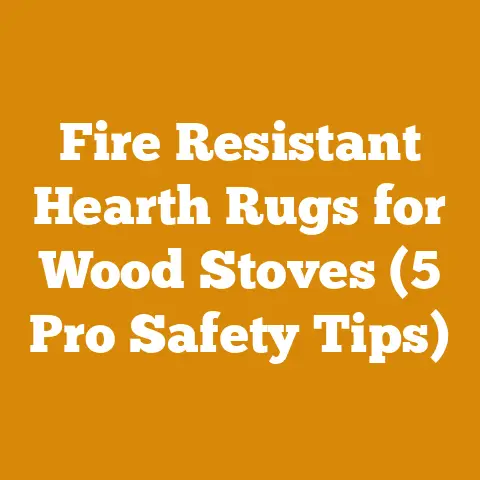How Do I Dispose of Old Railroad Ties? (5 Pro Wood Tips)
Ever stared at a stack of old railroad ties and wondered, “What on earth do I do with these things?” You’re not alone. Disposing of railroad ties isn’t as simple as tossing them in the trash. These hefty pieces of wood are often treated with chemicals, making their disposal a bit of a headache. But don’t worry; I’ve been there, wrestled with them, and learned a few tricks along the way. In this guide, I’ll share my top 5 pro tips on how to dispose of old railroad ties safely and responsibly. Let’s dive in!
How Do I Dispose of Old Railroad Ties? (5 Pro Wood Tips)
1. Understanding the Railroad Tie Dilemma
Before we get into the nitty-gritty of disposal, let’s understand what we’re dealing with. Railroad ties are typically treated with creosote, a coal-tar derivative used to protect the wood from insects, fungi, and rot. Creosote is effective, but it’s also a known carcinogen. This means it can pose health risks if not handled properly.
Why Creosote Matters:
- Health Concerns: Direct contact with creosote can cause skin irritation, and long-term exposure has been linked to cancer.
- Environmental Impact: Creosote can leach into the soil and water, contaminating the environment.
- Regulations: Due to these risks, many areas have strict regulations regarding the disposal and reuse of creosote-treated wood.
I remember one time, back in my early days of woodworking, I thought I could just burn some old railroad ties in my backyard. Big mistake! The fumes were acrid, and I quickly realized I was creating a toxic cloud. That’s when I learned the importance of proper disposal methods.
2. Tip #1: Check Local Regulations and Guidelines
The first and most crucial step is to check your local regulations regarding the disposal of treated wood. Regulations vary widely from state to state, and even from county to county. Some areas may allow landfill disposal, while others may require special handling or prohibit it altogether.
How to Find Local Regulations:
- Contact Your Local Waste Management Authority: This is usually the best place to start. They can provide specific guidelines for your area.
- Check with Your State’s Environmental Protection Agency (EPA): Many states have detailed information on their websites regarding the disposal of treated wood.
- Consult Your Local Department of Public Works: They often have information on waste disposal and recycling programs.
Example: In some states, like California, it’s illegal to burn creosote-treated wood. Landfill disposal may be allowed, but only at specific facilities that are equipped to handle hazardous waste. Ignoring these regulations can lead to hefty fines and other legal consequences.
3. Tip #2: Explore Repurposing Options (With Caution)
Repurposing railroad ties might seem like a great way to give them a new life, but it’s essential to proceed with caution. Due to the creosote treatment, there are limitations on how you can reuse them safely.
Acceptable Repurposing Uses:
- Non-Residential Landscaping: Using railroad ties for retaining walls or garden borders in commercial or industrial settings can sometimes be permissible. However, always check local regulations first.
- Erosion Control: In some cases, railroad ties can be used for erosion control in areas where human contact is minimal.
Uses to Avoid:
- Residential Landscaping: Avoid using railroad ties in residential gardens, especially where children play or where food crops are grown. The creosote can leach into the soil and pose health risks.
- Playground Equipment: Never use railroad ties for building playground equipment. The risk of direct contact with creosote is too high.
- Firewood: Burning railroad ties is a definite no-no. The fumes are toxic and can contaminate the air.
Personal Story: I once had a client who wanted to use railroad ties to build a raised garden bed. I had to explain to them the risks of creosote leaching into the soil and potentially contaminating their vegetables. We ended up using cedar instead, which is a much safer and more sustainable option.
Data Point: Studies have shown that creosote can persist in the soil for many years, potentially affecting plant growth and soil health.
4. Tip #3: Consider Professional Removal and Disposal Services
If you’re not comfortable handling railroad ties yourself, or if your local regulations are particularly strict, consider hiring a professional removal and disposal service. These companies specialize in handling hazardous waste and can ensure that the ties are disposed of safely and legally.
Benefits of Hiring Professionals:
- Expertise: They have the knowledge and experience to handle treated wood properly.
- Equipment: They have the necessary equipment for safe removal and transportation.
- Compliance: They ensure that the disposal process complies with all local and federal regulations.
- Peace of Mind: You can rest easy knowing that the ties are being disposed of responsibly.
Cost Considerations: The cost of professional removal and disposal can vary depending on the number of ties, the location, and the complexity of the job. Get quotes from several companies to find the best price.
Case Study: A local logging company I know recently had to remove a large number of old railroad ties from a property they were clearing. They hired a specialized disposal company that used a crane to lift the ties onto a flatbed truck and transport them to a designated hazardous waste facility. The process was efficient and ensured that the ties were handled safely.
5. Tip #4: Explore Landfill Disposal (With Precautions)
In some areas, landfill disposal may be an option, but it’s essential to follow specific guidelines to minimize the environmental impact.
Precautions for Landfill Disposal:
- Contact the Landfill: Check with the landfill to ensure they accept creosote-treated wood. Some landfills may have restrictions or require special handling.
- Wrap the Ties: Wrap the railroad ties in heavy-duty plastic sheeting to prevent creosote from leaching into the soil.
- Secure the Load: Secure the load properly to prevent the ties from shifting during transportation.
- Inform the Landfill: Inform the landfill personnel that you are disposing of creosote-treated wood.
Data Point: Landfills that accept treated wood often have special liners and leachate collection systems to prevent contamination of groundwater.
My Experience: I once helped a friend dispose of some railroad ties at a local landfill. We wrapped each tie in thick plastic and secured them to his truck with heavy-duty straps. When we arrived at the landfill, we informed the attendant that we were disposing of treated wood, and they directed us to a specific area.
6. Tip #5: Consider Alternative Wood Treatment Options
If you’re planning a new project and want to avoid the hassle of disposing of creosote-treated wood in the future, consider using alternative wood treatment options. There are several safer and more environmentally friendly alternatives available.
Alternative Wood Treatment Options:
- Pressure-Treated Lumber (ACQ): ACQ (Alkaline Copper Quaternary) is a water-based preservative that is less toxic than creosote. It’s commonly used for decks, fences, and other outdoor projects.
- Borate-Treated Wood: Borate is a naturally occurring mineral that is effective at preventing insect and fungal attack. It’s often used for interior applications.
- Naturally Durable Wood Species: Some wood species, such as cedar, redwood, and black locust, are naturally resistant to decay and insects. These species can be used without any chemical treatment.
Data Point: The use of ACQ-treated lumber has increased significantly in recent years as a safer alternative to creosote-treated wood.
Example: For my own landscaping projects, I prefer to use cedar. It’s naturally beautiful, durable, and doesn’t require any chemical treatment. Plus, it smells amazing!
7. Safety First: Handling Railroad Ties with Care
Regardless of the disposal method you choose, it’s essential to handle railroad ties with care to minimize the risk of exposure to creosote.
Safety Precautions:
- Wear Protective Gear: Always wear gloves, long sleeves, and eye protection when handling railroad ties.
- Avoid Skin Contact: Minimize direct contact with the wood.
- Wash Hands Thoroughly: Wash your hands thoroughly with soap and water after handling railroad ties.
- Work in a Well-Ventilated Area: If you’re cutting or drilling railroad ties, work in a well-ventilated area to avoid inhaling the fumes.
- Use a Dust Mask: Wear a dust mask to prevent inhaling wood dust.
First Aid: If you get creosote on your skin, wash it off immediately with soap and water. If you experience any skin irritation or other symptoms, consult a doctor.
8. The Environmental Impact of Improper Disposal
Improper disposal of railroad ties can have significant environmental consequences. Creosote can leach into the soil and water, contaminating the environment and harming wildlife.
Environmental Risks:
- Soil Contamination: Creosote can persist in the soil for many years, affecting plant growth and soil health.
- Water Contamination: Creosote can contaminate groundwater and surface water, harming aquatic life and potentially affecting drinking water sources.
- Air Pollution: Burning railroad ties releases toxic fumes into the air, contributing to air pollution and posing health risks.
Sustainable Practices: By following proper disposal methods and choosing alternative wood treatment options, we can minimize the environmental impact and protect our natural resources.
9. Understanding the Cost of Disposal
The cost of disposing of railroad ties can vary depending on several factors, including the disposal method, the location, and the number of ties.
Cost Factors:
- Landfill Fees: Landfills typically charge a fee for accepting waste. The fee may be higher for treated wood.
- Transportation Costs: The cost of transporting the ties to the disposal site can vary depending on the distance and the type of vehicle used.
- Professional Removal Fees: Hiring a professional removal and disposal service can be more expensive than DIY disposal, but it ensures that the job is done safely and legally.
- Wrapping Materials: If you’re disposing of the ties at a landfill, you’ll need to purchase heavy-duty plastic sheeting to wrap them.
Cost-Effective Strategies:
- Compare Prices: Get quotes from several disposal companies and landfills to find the best price.
- Recycle or Repurpose: If possible, recycle or repurpose the ties to avoid disposal costs altogether.
- Plan Ahead: Plan your disposal project carefully to minimize transportation costs and other expenses.
Data Point: The cost of disposing of a single railroad tie can range from \$20 to \$100, depending on the disposal method and location.
10. Case Studies: Real-World Disposal Projects
Let’s take a look at some real-world examples of railroad tie disposal projects to illustrate the different methods and considerations.
Case Study 1: Residential Landscaping Project
A homeowner in Oregon had several old railroad ties that were used to build a retaining wall in their backyard. They wanted to remove the ties and replace them with a more environmentally friendly option.
- Disposal Method: The homeowner contacted their local waste management authority and learned that landfill disposal was allowed, but the ties had to be wrapped in plastic.
- Process: The homeowner wrapped each tie in heavy-duty plastic sheeting and transported them to the local landfill.
- Cost: The landfill fee was \$30 per tie, and the cost of the plastic sheeting was \$50.
- Outcome: The homeowner successfully disposed of the railroad ties in compliance with local regulations.
Case Study 2: Commercial Property Renovation
A commercial property owner in California had a large number of old railroad ties that were used to create a decorative border around their parking lot. They wanted to remove the ties and replace them with concrete curbs.
- Disposal Method: The property owner hired a professional removal and disposal service.
- Process: The disposal company used a crane to lift the ties onto a flatbed truck and transport them to a designated hazardous waste facility.
- Cost: The total cost of the removal and disposal was \$5,000.
- Outcome: The property owner ensured that the railroad ties were disposed of safely and legally, avoiding any potential environmental liabilities.
Case Study 3: Rural Property Cleanup
A landowner in rural Texas had a stack of old railroad ties that had been left on their property by a previous owner. They wanted to clean up the property and get rid of the ties.
- Disposal Method: The landowner contacted their local landfill and learned that they accepted treated wood, but it had to be properly secured.
- Process: The landowner used a tractor to load the ties onto a trailer and transported them to the landfill. They secured the load with heavy-duty straps.
- Cost: The landfill fee was \$25 per load.
- Outcome: The landowner successfully disposed of the railroad ties at a reasonable cost.
11. The Future of Wood Treatment and Disposal
As environmental awareness continues to grow, the wood treatment industry is evolving to develop safer and more sustainable alternatives to creosote.
Trends in Wood Treatment:
- Increased Use of ACQ and Borate: These water-based preservatives are becoming increasingly popular as safer alternatives to creosote.
- Development of Bio-Based Preservatives: Researchers are exploring the use of natural substances, such as plant extracts and fungi, as wood preservatives.
- Improved Recycling Technologies: Efforts are underway to develop more efficient and cost-effective methods for recycling treated wood.
Future Considerations:
- Stricter Regulations: Regulations regarding the disposal of treated wood are likely to become stricter in the future.
- Increased Consumer Demand for Sustainable Products: Consumers are increasingly demanding environmentally friendly products, including wood treated with safer preservatives.
- Innovation in Wood Preservation: Ongoing research and development will lead to new and improved wood preservation technologies.
12. Actionable Takeaways for Responsible Disposal
To recap, here are some actionable takeaways to ensure responsible disposal of old railroad ties:
- Check Local Regulations: Always start by checking your local regulations regarding the disposal of treated wood.
- Consider Repurposing (With Caution): Repurpose ties only for non-residential landscaping or erosion control, avoiding contact with people, food or play areas.
- Hire Professionals: If unsure, hire a professional removal and disposal service.
- Landfill Disposal (With Precautions): If landfill disposal is allowed, wrap the ties in heavy-duty plastic and inform the landfill personnel.
- Choose Alternative Wood Treatment: For new projects, opt for safer alternatives like ACQ-treated lumber or naturally durable wood species.
- Prioritize Safety: Always wear protective gear when handling railroad ties and avoid direct skin contact.
- Understand the Environmental Impact: Be aware of the environmental risks of improper disposal and choose sustainable practices.
- Assess the Costs: Consider the costs associated with different disposal methods and plan accordingly.
- Stay Informed: Keep up-to-date on the latest trends and regulations in wood treatment and disposal.
13. Common Mistakes to Avoid
- Burning Railroad Ties: Never burn railroad ties. The fumes are toxic and can cause serious health problems.
- Using Railroad Ties in Residential Gardens: Avoid using railroad ties in residential gardens, especially where children play or where food crops are grown.
- Ignoring Local Regulations: Failing to comply with local regulations can result in fines and other legal consequences.
- Handling Railroad Ties Without Protective Gear: Always wear gloves, long sleeves, and eye protection when handling railroad ties.
- Assuming All Landfills Accept Treated Wood: Check with the landfill to ensure they accept creosote-treated wood.
14. Additional Resources and Support
- Local Waste Management Authority: Contact your local waste management authority for specific guidelines on waste disposal in your area.
- State Environmental Protection Agency (EPA): Check your state’s EPA website for detailed information on the disposal of treated wood.
- Local Department of Public Works: Consult your local department of public works for information on waste disposal and recycling programs.
- Professional Removal and Disposal Services: Search online for professional removal and disposal services in your area.
- Wood Preservation Associations: Contact wood preservation associations for information on alternative wood treatment options.
15. Final Thoughts: Making Responsible Choices
Disposing of old railroad ties can be a challenging task, but by following these pro tips, you can ensure that you’re doing it safely, responsibly, and in compliance with local regulations. Remember to prioritize safety, consider the environmental impact, and explore all available options before making a decision. By making informed choices, we can protect our health, our environment, and our communities.
I hope this guide has been helpful. Stay informed, stay safe, and keep creating!






